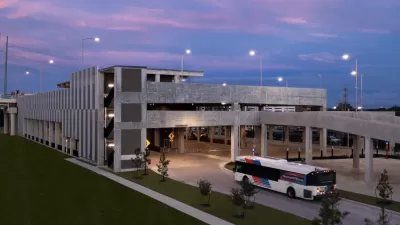To ease community concerns, the agency is proposing an underpass in lieu of a prior plan that would have elevated a new rapid transit line above a portion of its downtown route.

After backlash from community groups, Houston’s Metropolitan Transportation Authority (Metro) announced it would nix plans to build an overpass for the University Corridor bus rapid transit (BRT) route, opting instead for an underpass that “would allow buses, and emergency vehicles if necessary, to drive below the Union Pacific Railroad tracks, which are another source of frustration for the East End community. A pedestrian and bicycle path also would flow under the tracks, while automobile drivers still would cross the tracks at ground level.”
Dug Begley describes the changes in the Houston Chronicle, whose editorial board has called the University Corridor line a “crucial project.” The underpass option would give buses a dedicated lane and let them avoid delays at the train crossing without requiring extra space. “Officials believe they can control flooding, based on the most current county flood maps, by installing flood gates Metro can manage.”
As Begley explains, “The decision to ditch the planned overpass at Lockwood and Harrisburg, following weeks of discussion and at the urging of local elected officials, clears Metro to approve its preferred route for the University Corridor, the 25.3-mile backbone of planned bus rapid transit in the region.”
Begley notes that it remains unclear whether the changes will appease critics of the project. “Skeptics of Metro’s $7.5 billion long-range plan, approved by voters in 2019, note that the Silver Line buses, predicted to carry thousands of shoppers in workers in The Galleria area, snake mostly empty along the street because of changes in commuting patterns following the COVID pandemic that has meant fewer commuters coming into the area five days a week.”
FULL STORY: Metro pitches underpass to ease East End concerns about University Corridor BRT route. Is it enough?

Planetizen Federal Action Tracker
A weekly monitor of how Trump’s orders and actions are impacting planners and planning in America.

San Francisco's School District Spent $105M To Build Affordable Housing for Teachers — And That's Just the Beginning
SFUSD joins a growing list of school districts using their land holdings to address housing affordability challenges faced by their own employees.

The Tiny, Adorable $7,000 Car Turning Japan Onto EVs
The single seat Mibot charges from a regular plug as quickly as an iPad, and is about half the price of an average EV.

Seattle's Plan for Adopting Driverless Cars
Equity, safety, accessibility and affordability are front of mind as the city prepares for robotaxis and other autonomous vehicles.

As Trump Phases Out FEMA, Is It Time to Flee the Floodplains?
With less federal funding available for disaster relief efforts, the need to relocate at-risk communities is more urgent than ever.

With Protected Lanes, 460% More People Commute by Bike
For those needing more ammo, more data proving what we already knew is here.
Urban Design for Planners 1: Software Tools
This six-course series explores essential urban design concepts using open source software and equips planners with the tools they need to participate fully in the urban design process.
Planning for Universal Design
Learn the tools for implementing Universal Design in planning regulations.
Smith Gee Studio
City of Charlotte
City of Camden Redevelopment Agency
City of Astoria
Transportation Research & Education Center (TREC) at Portland State University
US High Speed Rail Association
City of Camden Redevelopment Agency
Municipality of Princeton (NJ)





























